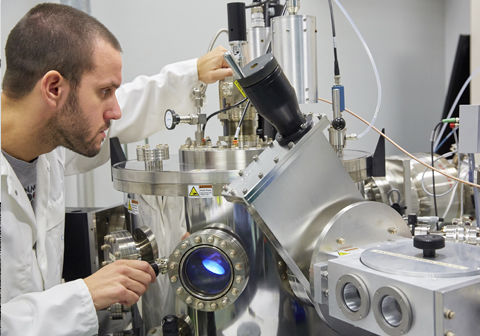Lorenzo Fallarino, a researcher who has been awarded a PhD by the UPV/EHU-University of the Basque Country, has designed, built and characterised thin films and multilayers of magnetic alloys at CIC nanoGUNE (Co-operative Research Centre). Their properties are promising not only for the study of magnetism itself but also for their future technological applications. These are new materials that can be used in new techniques for magnetic recording based on local heating using laser.
New techniques in magnetic recording
CIC nanoGUNE eta UPV/EHUko ikerketa batean garatutako materialen propietate magnetikoak oso aproposak izan litezke datuak gordetzeko teknika berrietarako
First publication date: 28/06/2017

One of the main pillars of science is the quest for new materials with novel properties and, in this respect, the fundamental or basic research is conducted without any immediate practical purposes with the aim of expanding knowledge about the fundamental principles of nature or of reality itself. The aim of the project by Lorenzo Fallarino, the researcher awarded a PhD by the UPV/EHU, was to seek new materials that can be used to improve the systems of magnetic recording memories of computers and also to explore the magnetic, physical, electrical and elastic properties of these materials.
In the CIC nanoGUNE Nanomagnetism group Fallarino has designed, manufactured and characterised cobalt alloys with chromium, ruthenium and platinum as well as chromium oxide alloys. The researcher has explored the magnetic properties of these materials by varying their design so as to be able to use them in promising magnetic recording techniques as the magnetic properties in these materials depend directly on their crystalline structure.
These are materials with a thickness on a nanometric scale (between 1-2 nm to 100 nm) and a perfectly defined crystalline structure and they are gradually deposited on extremely thin silicon wafers. "The growing demand for small devices has made the study and development of new materials on the nanometric scale very important," he explained. Furthermore, "when these materials are reduced to this scale, new phenomena or new physical properties gradually appear and their impact for science and industry is high. When we alter the crystalline structure of the material, for example, its magnetic properties can be modified and adjusted for the technological applications we are seeking".
Technology transfer
Thanks to the experience of qualified researchers in the Nanomagnetism group at nanoGUNE, Lorenzo Fallarino has managed to produce alloys that allow the Curie temperature to be manipulated. The Curie temperature is defined as one at which ferromagnetic materials no longer behave as such, in other words, materials that have behaved as magnets stop doing so above this temperature and as a general rule it tends to be very high. The researchers in the group were interested in studying alloys with a low Curie temperature, close to ambient temperature because "there was a considerable gap in the information in this respect".
Lorenzo Fallarino stressed that "it is very unlikely that the results of this research will be seen in the short term in magnetic memories", but he pointed out that "these new materials are very promising for the development of new magnetic recording techniques that use local heating through laser", so he highlights the importance of the technology transfer of these results because "industry will be the main player in the future development of these materials".
Fallarino also stressed that "we have discovered that these materials are highly suited to the study of the basic physics of magnetism. There remains a whole world to be discovered and learnt on the subject of magnetism".
Additional information
Lorenzo Fallarino (Città della Pieve, Italy, 1985) received a degree in Physics from the University of Perugia (Italy) and has been awarded a PhD by the UPV/EHU after writing up his PhD thesis entitled Fabrication and characterization of magnetic thin films and multilayers, in nanoGUNE's Nanomagnetism group. His supervisor was Dr Andreas Berger.
Bibliographic reference
- Magnetic properties of epitaxial CoCr films with depth-dependent exchange-coupling profiles
- Physical Review B (2017; Vol.95,)
- DOI: 10.1103/PhysRevB.95.134445

